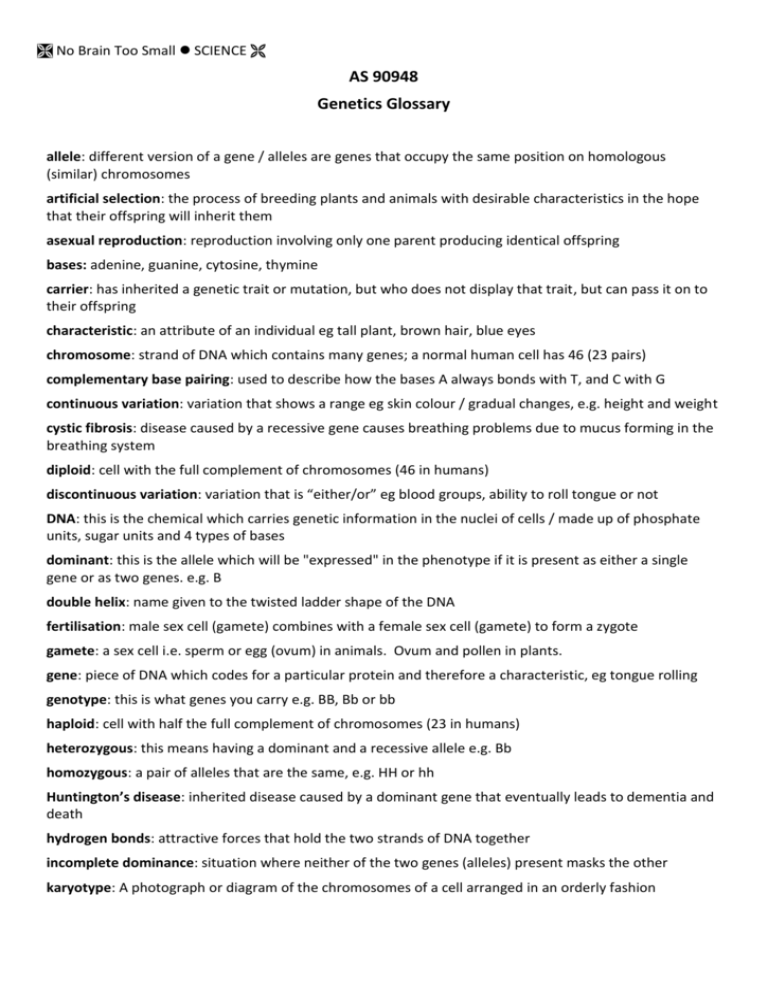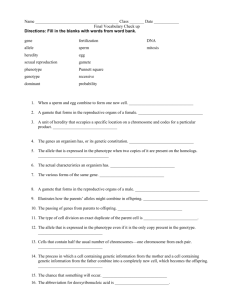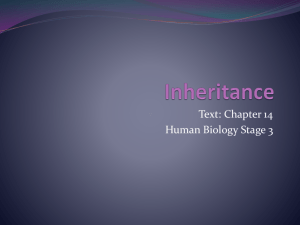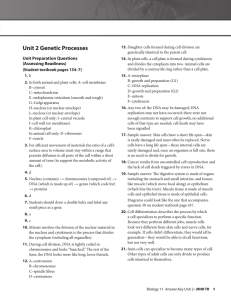AS 90948 Genetics Glossary
advertisement

No Brain Too Small SCIENCE AS 90948 Genetics Glossary allele: different version of a gene / alleles are genes that occupy the same position on homologous (similar) chromosomes artificial selection: the process of breeding plants and animals with desirable characteristics in the hope that their offspring will inherit them asexual reproduction: reproduction involving only one parent producing identical offspring bases: adenine, guanine, cytosine, thymine carrier: has inherited a genetic trait or mutation, but who does not display that trait, but can pass it on to their offspring characteristic: an attribute of an individual eg tall plant, brown hair, blue eyes chromosome: strand of DNA which contains many genes; a normal human cell has 46 (23 pairs) complementary base pairing: used to describe how the bases A always bonds with T, and C with G continuous variation: variation that shows a range eg skin colour / gradual changes, e.g. height and weight cystic fibrosis: disease caused by a recessive gene causes breathing problems due to mucus forming in the breathing system diploid: cell with the full complement of chromosomes (46 in humans) discontinuous variation: variation that is “either/or” eg blood groups, ability to roll tongue or not DNA: this is the chemical which carries genetic information in the nuclei of cells / made up of phosphate units, sugar units and 4 types of bases dominant: this is the allele which will be "expressed" in the phenotype if it is present as either a single gene or as two genes. e.g. B double helix: name given to the twisted ladder shape of the DNA fertilisation: male sex cell (gamete) combines with a female sex cell (gamete) to form a zygote gamete: a sex cell i.e. sperm or egg (ovum) in animals. Ovum and pollen in plants. gene: piece of DNA which codes for a particular protein and therefore a characteristic, eg tongue rolling genotype: this is what genes you carry e.g. BB, Bb or bb haploid: cell with half the full complement of chromosomes (23 in humans) heterozygous: this means having a dominant and a recessive allele e.g. Bb homozygous: a pair of alleles that are the same, e.g. HH or hh Huntington’s disease: inherited disease caused by a dominant gene that eventually leads to dementia and death hydrogen bonds: attractive forces that hold the two strands of DNA together incomplete dominance: situation where neither of the two genes (alleles) present masks the other karyotype: A photograph or diagram of the chromosomes of a cell arranged in an orderly fashion No Brain Too Small SCIENCE meiosis: this is cell division that reduces the number of chromosomes to a half the normal number, producing 4 genetically different cells. This is what happens in the testis and ovary; meiosis produces gametes mitosis: this is a genetically exact division of a cell – produces 2 identical daughter cells monohybrid cross: a straight forward cross involving only one pair of genes or alleles mutation: this is a sudden, permanent change in a gene or whole chromosome natural selection: organisms with characteristics best suited to their environment become more successful, and so expand in numbers nucleotide: a UNIT built up of a base, a sugar and a phosphate group pedigree chart: A family tree drawn with standard genetic symbols, showing inheritance patterns for specific characteristics e.g. straight/curly hair phenotype ratio: ratio of phenotypes e.g. 3 brown hair : 1 blond hair (a prediction of the phenotypes and their occurrence as a result of a cross) phenotype: the expression of the genotype; this is what you look like e.g. brown or blue eyes, if it is a visible trait phosphate: group that alternates with the ribose sugar in the DNA backbone Punnett square: name given to the grid of squares that may be drawn to show the range of combinations of genes that may occur pure breeding: A group of identical individuals that always produce offspring of the same phenotype when interbred / are homozygous individuals eg either BB or bb recessive: this is the allele which is only expressed if these are two such alleles e.g. b reduction division: another name for meiosis ribose: a sugar group that alternates with the phosphate group in the DNA backbone semi conservative: each double-stranded DNA molecule is composed of one parental strand and one newly made strand sexual reproduction: reproduction involving two parents, where the offspring has some features inherited from each symbols: use of capital letter for the dominant gene and the same small letter for the recessive gene, e.g. R for round pea and r for wrinkled pea, where round is dominant template: pattern trait: another word for characteristics, eg brown hair is an example triplet code: genetic code made by a sequences of three bases in the DNA e.g. AAA, GCT, CAT etc variation: the differences among parents and their offspring or among individuals in a population zygote: cell formed when a sperm cell fuses with an egg cell










